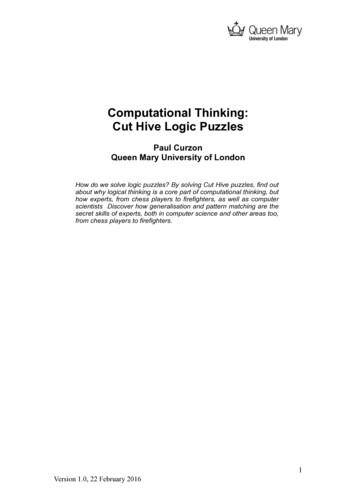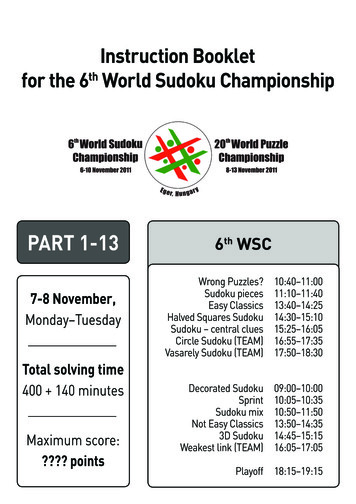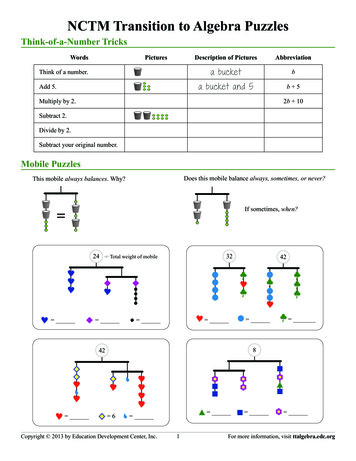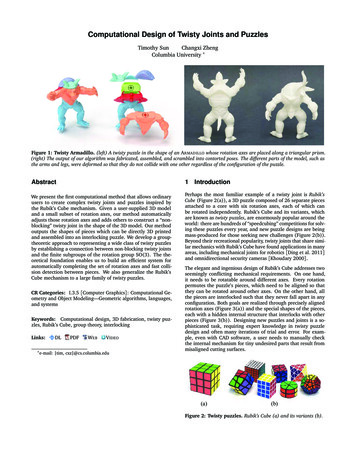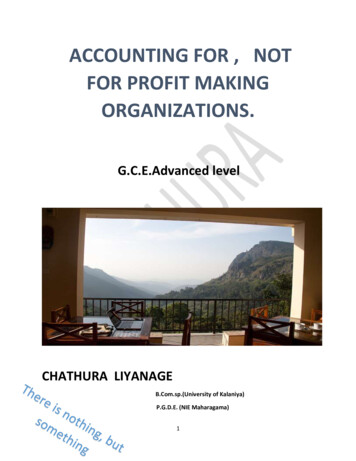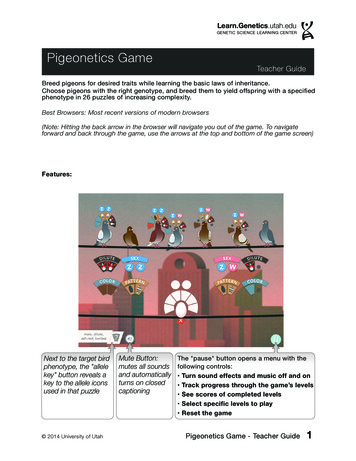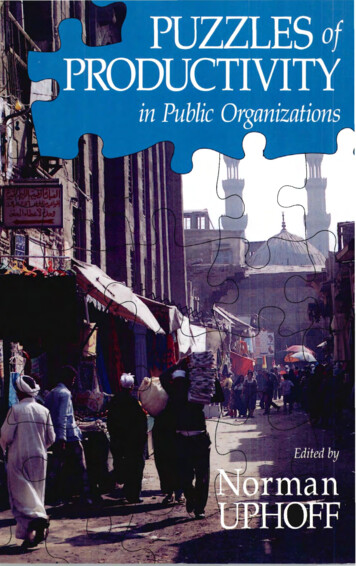
Transcription
Puzzles of Productivityin Public OrganizationsA publication of theInternational Center for Self-Governance
The mission of the International Center for Self-Governance is to encourage men and women in developing countries to achieve the self-governingand entrepreneurial way of life. In addition to publishing the finest academic studies, such as this edition of Puzzles of Productivity in PublicOrganizations, ICSG also provides practical materials in a variety of readilyaccessible formats, including manuals, learning tools, and interactive tasks.For more information on ICSG or its publications, training materials, andvideos, please contact:ICSG720 Market StreetSan Francisco, CA 94102 USA(415) 981-5353
Puzzles of Productivityin Public OrganizationsEdited byNorman Uphoff([!PRESSInstitute for Contemporary StudiesSan Francisco, California
1994 Institute for Contemporary StudiesThis book is a publication of the International Center for Self-Governance,dedicated to promoting the self-governing and entrepreneurial way of lifearound the world. The Center is affiliated with the Institute for ContemporaryStudies, a nonpartisan, nonprofit public policy research organization. The analyses,conclusions, and opinions expressed in ICS Press publications are those of theauthors and not necessarily those of the Institute for Contemporary Studies, orof the Institute's officers, director, or others associated with, or funding, its work.Publication of this book was funded by the U.S. Agency for InternationalDevelopment.Printed in the United States ofAmerica on acid-free paper. All rights reserved. Nopart of this book may be used or reproduced in any manner without writtenpermission except in the case of brief quotations in critical articles and reviews.Inquiries, book orders, and catalog requests should be addressed to ICS Press,720 Market Street, San Francisco, California 94102 USA. Telephone: (415)981-5353. Fax: (415) 986-4878. For book orders and catalog requests call toll freein the contiguous United States: (800) 326-0263.Project editor: Michael]. KloessProofreader: Lura DymondIndexer: Shirley KesselLibrary of Congress Cataloging-in-PubUcation DataPuzzles of productivity in public organizations/edited by NormanUphoff. p.cm.Includes bibliographical references and index.ISBN 1-55815-291-1 (paper)1. Government productivity-Developing countries-Case studies.2. Public administration-Developing countries-Case studies.I. Uphoff, Norman Thomas.JF1525.P67P89 1994351.001'09172'4-dc2093-47560CIP
Dedicated to our esteemedcolleague and teacher,Milton J Esman
Contents1.2.LIST OF TABLESixLIST OF FIGURESixFOREWORDRobert B. Hawkins, Jr.xiReassessing Development Administration: Puzzles ofProductivityNonnan UphoffAnalyzing and Closing the Performance Gap inBangladesh: Three ApproachesHarry W Blair3. Management and Productivity in Kenyan State EnterprisesDavid K Leonard4.Mentalite, Rationality, and Productivity: SandinistaAdministration of State Enterprises in NicaraguaForrest D. Colburn11743595. Donor Support for Decentralization in Peru in ControlOriented BureaucraciesGregory D. Schmidt716. Dealing with Gaps in Public Sector Performance:Institutional Development Experience of the World BankArturo Israel7.The Strategic Setting of Administrative'Reform: Thoughtson Roles and CrustsJohn D. Montgomeryvii99121
viii8.ContentsAlternative Understandings of Performance GapsLouise G. White1399. Effectiveness versus Efficiency in Organizations: Insightsfrom Strategic ManagementArthur A. Goldsmith15510. Advantages and Disadvantages of Hierarchy: Exploring theLimits of Bureaucratic Reorientation and ReformNorman K NicholsonII.Revisiting Institution Building: How OrganizationsBecome Institutions. Norman Uphoff16919912. Applied Organization Theory in DevelopmentAdministrationNorman Uphoff217BIBLIOGRAPHY235CONTRIBUTORS253INDEX257
List of Tables2.1Progress in Physical Quality of Life Indicators (PQU) forSelected Asian Countries, Mid-1960s to Mid-1980s2.2 Growth in Rice Production and in GNP per Capita forSelected Asian Countries, early 1960s to Late 1980s3.1 Average Annual Operating Costs of the Kenya TeaDevelopment Authority3.2 Kenya Tea Development Authority Factory Costs4.1 Nicaraguan Economic Indicators, 1985-908.1 Six Perspectives on Improving Organizational Performance11.1 Different Categories of Institutions and Organizations2324505160143203List of Figures.6.111.1Schematic Representation of Performance GapsOverlapping Relation between Organizations andInstitutions11.2 Dimensions Making for Organizational Productivity11.3 Dimensions Making for Institutional Productivityix101203206208
ForewordLike almost everything else in the world today, both the theory and thepractice of public administration are in a state of change. Our old theoriesprovide little guidance. The old assumptions of public administration-ofcommand and control, and top-down prescription of universal solutionshave proved to be inadequate in the face of pervasive change. That is, themechanistic model of productivity-reliably converting inputs to outputsno longer holds up in the complex world of public affairs.The challenge all students of public administration face is an intellectual crisis now made clear by the increasing puzzles in productivity. So ourtask is to begin crafting new theoretical tools that can be used to design newinstitutions that have a greater chance of success, and that will advance societyon more human and organic terms. In every crisis there is also opportunity,which offers all students of public administration an exciting challenge.In Puzzles of Productivity in Public Organizations, Norman Uphoffpresents incisive examples of the most current thought on how to addressthe gap between the potential and actual performance of public organizations in developing countries. The essays examine the problems ofadministrative productivity from a variety of viewpoints, including those oforganization theory, strategic management, public choice theory, and institution building.Especially in the developing countries, a shift in perspective is imperative. Responding to a changing world will require a new orientation for thepublic sector. Instead of merely providing and producing services, publicorganizations must become enablers, or catalysts, in meeting demand forgoods and services. Education, health, safety, agricultural development, andother benefits once thought to be the domain of the public sector will becreated jointly by citizens, communities, and a rich array of organizationsconfigurations that will defy the neat distinctions of public and private.Public administration also faces a set of moral questions as we hopefully enter an era of democracy and self-government. The key role thatxi
xiiForewordcitizens play in the production of all services is evident. It is a time in whichcitizens must be treated as ends in win-win strategies, rather than as meansin large-scale programs. As public administration begins to see its role innurturing and developing the capacities of citizens and communities tobecome self-governing and entrepreneurial, exciting moral, intellectual,and organizational tasks await.The International Center for Self-Governance believes that the widerange of perspectives as well as the blend of theory and field experience inPuzzles of Productivity in Public Organizations will make this book anunusually valuable resource for those who seek to broaden their understanding of administrative productivity, particularly in developingcountries.Robert B. Hawkins, Jr.PresidentInstitute for Contemporary Studies
1Reassessing DevelopmentAdministration:Puzzles of ProductivityNorman UphoffThis volume explores sources of, explanations for, and solutions to theubiquitous gap between public bureaucracies' potential levels of performance and the actual levels observed. What accounts for this differential?And what can be done about it? These are some of the most importantpuzzles for students of public administration as we reach the end of acentury that has seen the growing power of public organizations around theworld, and a growing disillusionment of the public with their performance.At present, despite decades of research and analysis, the questions wecan frame are more satisfactory than our answers. Had this book beenwritten ten years ago, it might have suggested that public. organizationswere a diminishing if not vanishing species, and that the main issue is howto contract the public sector and expand the private one. But enthusiasmsfor pure privatization appear to have peaked, and we have reason toexamine how public organizations can best play their many roles incontributing to public well-being and progress, particularly in the lessdeveloped countries.A Retrospective View of the TwentiethCenturyThis century, despite some paroxysms of totalitarianism, has been mostmarked in political and administrative terms by the pervasive growth of thewelfare state, at least into the 1980s, and by the ascendancy of the securitystate, at least into the 1990s. These constructions, which vastly expanded the
2Norman Uphoffpublic sector, were first evident in Europe and North America. But aspiringwelfare states, providing education, health, agricultural, transportation,commercial, and other services emerged throughout Asia, Africa, and LatinAmerica, accompanied by expanding and often dominating militaryestablishments.Public sector management by the middle ofthe twentieth century was aconfident, well-endowed enterprise, professionally and intellectually, and itenjoyed several decades of preeminence. But few if any trends in this worldare linear and continuous. Starting in the mid-1970s, critical voices grew innumber and volume, as taxpayers' revolts spread across Europe and NorthAmerica, cramping and often curtailing the operations of their respectivewelfare states. The fiscal capabilities of many of the more prosperousnation-states were eviscerated by a combination of conservative fiscalpolicies and economic deceleration in the 1980s.In the poorer countries of the world, where development administration concerns are focused, the dominant policy thrust throughout the 1980s,promoted by international actors, was "structural adjustment." This required major retrenchments of the public sectors in Asia, Africa, and LatinAmerica. "Privatization" became a watchword for solving many if not all ofthe deficiencies in countries' performance for meeting economic and socialneeds.! At the close of the 1980s, people in the Soviet bloc scuttled thepolitical and economic systems that had helped to create and accelerate theworldwide arms race. This unexpected event made it possible to contemplate a post-Cold War world without massive security apparatuses.Judging by events and trends of the 1980s, one might have expected thetask of public administration theorists and practitioners in the 1990s to beretracting and redeploying public sector capacities in favor of privateenterprise operations. Indeed, the only category of public sector organizations not seriously set back seems to be the military establishments inpoorer countries, and even many of these have had to give way recently tocivilian governments. A worldwide movement for democratization hasbeen gaining momentum alongside private sector expansion under thebanner of "free markets and free societies." However, we are dealing notjust with two sectors, public and private, but rather with three. As discussedlater in this essay, a variously named third or "middle" sector has expandedvigorously in recent years. 2It is almost everywhere acknowledged that active, effective publicsectors are needed to promote and maintain free markets, to countervailmonopolistic tendencies, to operate legal systems, to enforce contracts, toinvest in basic infrastructure, and to provide needed public goods. Whilecutting taxes continues to be popular, a point of diminishing returns isreached when producing popular satisfaction is balanced against the needfor a certain range and depth of public services. Though the World Bank
Reassessing Development Administration3through most of the 1980s was aggressively downsizing developing countries' government apparatuses in line with the goals of structural adjustment, by the end of the decade, its president, Barber Conable, observed:Aroot cause of weak economic performance in the past has been thefailure ofpublic institutions. Private sector initiative and market mechanisms are important, but they must go hand-in-hand with goodgovernance-a public service that is effiCient, a judicial system that isreliable, and an administration that is accountable to the public. (WorldBank 1989: xii)Similarly, strong, even-handed governments are recognized as essential to sustain free societies, to protect minority rights, to ensure widespread access to the essential public goods of education and information,and to mitigate extremes in socioeconomic inequality. This need hasbecome more obvious as names like Sarajevo, Mogadishu, and Ayodhyahave seared the world's consciousness and conscience. The organizedexpressions of "civil society"-associations, cooperatives, universities,foundations, trade unions, etc.-are needed to ensure individual andgroup freedom. But their capabilities as intermediaries are truncatedwithout governmental institutions to relate to.The economic successes ofjapan, South Korea, Taiwan, and Singapore,followed by Thailand, Indonesia, and Malaysia, were interpreted for a whileas demonstrating the superiority of private sector-led development. Butmore thorough assessments showed state sector policies and institutions tohave been critical for realizing the potential of private initiatives.3 Even theadvantages claimed for delegating government functions to private contractors have proved less attractive than expected. 4All this means that as the twentieth century draws to a close, the pursuitof individual and collective goals will not be undertaken exclusively or evenpredominantly through private organizations, especially not in developingcountries where the private sector is weaker than in more prosperouscountries. To be sure, that prosperity is attributable in considerable part tothe number and productivity of private enterprises. Economic and socialprogress in Asia, Mrica, and Latin America will require a multi-fold expansion of nongovernmental organizations, both for-profit and not-for-profit.But there is likely to be a more level playing field among sectors thanimagined just a few years ago. Hierarchy and bureaucratic forms of organization may decline (Kantor 1991), but not necessarily the public sector.Any government claims to preeminence or dominance will not beaccepted as readily as in the past. There is now a greater burden of proof forexpanding or even often for maintaining their functions. But there is noneed to be apologetic when seeking to improve the performance of public
4Norman Uphoffsector organizations, partly because it is recognized that these can andshould contribute to the more productive functioning of private entities.There are complementarities and synergies to be achieved among all threesectors-public (governmental), private (for-profit), and nongovernmental(private but not-for-profit).For this end, we need to rethink the role, functions, and capabilities ofpublic organizations, attempting to "reinvent" development administrationto borrow a trenchant term from Osborne and Gaebler (1992), who havemade important contributions to this debate in America. Less attention hasbeen given to these questions for developing countries, but the issuesinvolved in such a reorientation are being addressed. sMany ideas and lessons can be shared between the wealthier andpoorer countries. In both there is need for more effective and efficient useof resources through public sector channels, for smarter and less routineoperations, for more creative and less conservative governments which canreduce multiple economic, social, and political detriments, so that privateindividual and collective action can be more effective (Mars 1992).Achieving greater productivity is important not just for the sake ofgreater output. Without "expanding the pie," there is likely to be littleimprovement in the condition of those persons and families who arecurrently most disadvantaged. And unless we learn how to produce goodsand services with fewer inputs, our detrimental impact on the environmentwill grow apace. A concern with productivity serves not just efficiency, butalso equity and ecological goals.Unfortunately, the concept of productivity usually connotes a mechanisticprocess, one of converting inputs to outputs. This perception is consistentwith the machine-like imagery offered in the writings of Max Weber, whoattributed the productivity of bureaucracy to its having regular operations,well-defined and interchangeable parts, that is, roles, fixed boundaries, andpredictable outputs. 6In many ways the model for bureaucracies has been the military. 7 Basicto both organizational models was the image of the machine, which hasreflected enthusiasm for the successes of both Newtonian mechanics andthe industrial revolution (Hirschman 1977). If public administration is tobe reinvented, with new approaches to increasing productivity, the underlying concept that has structured and animated the organizations chargedwith carrying out public sector programs needs to be reexamined (Morgan1986).The machine has contributed immensely to most of the economic andsocial advances of the twentieth century, though it also has been associatedwith some of its horrors and pathologies. Reconsidering developmentadministration is not a task for neo-Luddites. The debate here is not overwhether benefits can be derived from mechanical processes. The issue is
Reassessing Development Administration5more the intellectual one of considering how reductionist, mechanisticthinking has kept us from possible benefits that could and need to beattained.In the case of administration, it is increasingly evident that productivityand human potential have been diminished by regarding organizations inessentially mechanical terms rather than exploring their manifestations inmore human, social, and organic terms. In the spirit of contemporary times,we find that models of hierarchy are giving way to ones based more onnetworks (Thompson 1991).8Too often new ways ofthinking are proposed as alternatives to previousones. Critics of reductionist oversimplifications should themselves avoidthis in their own formulations. Any serious examination of puzzles ofproductivity must use the concepts of inputs and outputs. These conceptsare strongly associated not only with mechanical processes and analysis, butalso with organic ones. No choice should be forced between hierarchiesand networks, because hierarchies usually include and subsume somenetworks, just as networks are seldom without any superordination. We willtry to avoid simple either/or formulations, moving instead toward modelsthat reflect the complexities, ambiguities, and perplexities of the world ofpublic affairs.New Thinking in DevelopmentAdministrationRecognizing that this subdiscipline has become somewhat becalmed inrecent years, a number of colleagues, friends, and former students ofMiltonJ. Esman decided to draw on their experiences and perspectives in thissubject area to address the questions which opened this chapter. Whataccounts for the gap in the productivity of public organizations betweentheir potential levels of performance and the actual levels observed? Whatnew perspectives and approaches, building on what has been done before,can narrow this gap? These questions apply to public administrationgenerally, but they are most urgent and acute for developing countries.What can be said about them on the basis of stocktaking by researchers whohave had much practical engagement with these problems across Asia,Africa, and Latin America?Milton Esman has been a valuable contributor on this subject over thepast thirty years. In the early 1960s he was one of the pioneers who shapedthe concept and content ofthe field of development administration. He gaveleadership to the study of institution building, heading in its initial years theinteruniversity consortium that combined empirical and theoretical inquiry to develop a framework which, its limitations notwithstanding,
6Norman Uphoffachieved considerable acceptance and influence during the 1960s and1970s-especially in schools and institutes of public administration indeveloping countries and in a number of development assistance agencies.This framework, presented concisely in Esman (1972a and 1972b), isrevisited in Chapter 11. It stimulated much thought about the goals andprocesses of development and about the roles of agents of social change. Aparticular contribution was to stress that enhancing sustainable indigenouscapacities for improving people's productivity and well-being was a moreimportant task for development administration than simply and directlyincreasing instrumental efficiency.Starting in the 1970s, often with this author, Milton Esman focused onthe administrative and policy requirements of broad-based rural development. This focus helped to shift attention from capital accumulation,technology transfer, and trickle-down economics toward participatory approaches and more equitable distribution of benefits (e.g., Uphoff andEsman 1974; Esman 1977 and 1983; and Esman and Uphoff 1984). Esman(1991) reconceptualizes development administration by analyzing the pluralistic nature of state bureaucracies and of third world publics. The bookemphasizes the importance of networking not only among agencies of government but also between them, private enterprises, and NGOs, to shapeand prOVide a broad range of development services. Such arrangementsshould enhance the responsiveness of public and private organizations todiverse needs, capabilities, and preferences of publics.9 Throughout hiscareer, Esman also provided practical advice to many agencies and governments, some of it described in John Montgomery's essay in this volume.Esman's work has helped shape a generation of inquiry into how to helppublic organizations better serve the needs of their multiple publics,especially the more remote and less advantaged.The contributors to this volume have taken up the challenge toilluminate the problem of the productivity gap and to suggest ways it couldbe closed. Most of the authors approach problems of public administrationfrom the disciplinary base of political science, so it is not surprising thatmost find issues of leadership and accountability central to their discussion.Such conclusions are congruent with the heightened attention to issues ofgovernance and democratization that are now of concern to agencies suchas the World Bank, staffed mostly with economists.The original plan for the volume was to have some essays that probedthe administrative experience of developing countries that the authorsknew well first-hand to extract empirical clues to solving the puzzles ofraising productivity. Others would delve into the literature for moretheoretically-constructed answers. Such a separation into inductive anddeductive approaches was not tenable, however. Instead, we offer a progression from country-focused approaches to more conceptual treatments,
Reassessing Development Administration7with intermediate perspectives of how donors can make improvements inadministrative productivity. All the essays deal with the subject analyticallybut in different ways.In her 1987 book, Creating Opportunities for Change: Approaches toManaging Development Programs, Louise White mapped out six majoranalytical approaches in the development administration literature. For thisvolume, she elaborates that framework in terms that shed light on performance gaps. The six approaches actually represent three complementaryfocuses-on organizations, on their managers, and on their environments. The three essays in this volume that focus most directly on nationaladministrations-for Bangladesh (Blair), Kenya (Leonard), and Nicaragua(Colburn)-stress respectively:procedures and pressures that can induce accountability within organizations, so as to countervail influences from the environment andmodify managers' behavior2. how the initiative of managers can influence their environment as wellas their organization through leadership and political skills1.3. the effect that environments can have on productivity in organizationsand on managers' options through the influence of prevailing ideas,values, attitudes, and expectationsWe see from these case studies that the three focuses singled out analyticallyby White are definitely interactive and interdependent, but possible improvements in performance may be identified and dealt with in terms of anyone of them: organizational reforms, managerial initiatives, or environmental factors.The validity of White's three-fold focus of analysis and remediation isreinforced by the other essays in this volume. The reasons for success orfailure of World Bank institutional development efforts in borrowingcountries, as reported by Israel, range across all three categories (seeChapter 6). Schmidt's assessment of United States Agency for InternationalDevelopment (USAID) efforts in Peru to improve decentralized administrative capacities emphasizes organizational variables, while Montgomery'sreflections on external initiatives to strengthen administrative performancein Malaysia and Nepal highlight the importance of the environment-whathe calls "strategic settings." Both Montgomery and Schmidt appreciate, tobe sure, the contribution which all three sets of factors-managerial,organizational, and contextual-can make to good (or poor) performance,but they illuminate respectively environmental and organizational variables. The following essays' of Goldsmith, Nicholson, and this author
8Norman Uphoffsimilarly are concerned with all three sets of factors, but respectively focuson managerial, organizational, and environmental relationships. Productivepossibilities can be enhanced from anyone of these perspectives, but morefrom a combination of approaches.This way of understanding development administration makes it lessamenable to machine-like metaphors. The organization itself, the "machine" that is to be made more efficient, is only one of three focuses ofconcern and remediation. Moreover, organizations are regarded as connected to their environments in multiple ways that are more organic thanmechanical. The role of managers is seen more as molding and motivatingorganizations rather than just operating them, as one would a machine.These are important reconceptualizations, based on more appropriateimages of what the enterprise of development administration entails.Productivity in Public OrganizationsWhy is the standard model of organization-as a machine convertinginputs into outputs in predictable ways such as Weber described-notsufficient for our purposes? A concern with productivity, closely associatedwith machine metaphors, calls this model into question. The theory ofmechanical advantage tells us that a machine-as simple as a level, a ramp,or a screw-increases some quantum of input into a greater output.Organizations are expected to convert their inputs (materials, funds, personpower) into outputs (goods and/or services) that are of greater valuethan the inputs. A positive-sum process is supposed to make the totalgreater than the sum of its parts. Through organization, one should be ableto create a margin of value, thereby getting something (if not for nothing)for the cost of constructing this social version of a machine.As with so many things, there is a countervailing disadvantage, however,which can be characterized as friction. This impedes the conversion ofinputs into outputs and is a negative-sum factor affecting all mechanicaloperations. Friction may not cancel out all the benefits of mechanicaladvantage, but it diminishes them, possibly severely. In organizations, onecan identify many sources of friction, such as: processes of communication, negotiation, and enforcement, which getgrouped under the heading of "transaction costs," as discussed byNicholson later in this volume staff members' unwillingness or inability to do what is expected of them,due to self-interest, incompetence, laziness, corruption, or other causes interrupted or inappropriate inputs, and faulty throughput or distribution, slowing production processes and causing backlogs
Reassessing Development Administration9Organizational operations get further compromised by the need to expendresources on "redundancy" to assure that performance will be effectiveeven if it is not necessarily efficient. lO Indeed, an advantage of organizations,as machines, is often not so much their efficiency as their ability to produce,as machines do, relatively standardized and predictable outputs.A major puzzle of productivity in public organizations, which is somewhat more obvious for them than for other types of organization, is whyoutputs are not more dearly, explicably, and reliablyproportional to inputs.There is little linear correlation between the resources expended through aunit ofbureaucracy and the results produced, as should occur with mechanical processes. The accomplishments of bureaucracies are supposed to begreater than the cost of operating them, but especially in developingcountries, this is sadly not the rule. Lapses in performance can be explainedin terms of friction, which appears to be greater in human organizationsthan Weber described. Transaction costs, staff commitment to extraorganizational interests (e.g., family or ethnic affiliations), and uncertaintiesin input-to-output conversion processes are arguably greater in LDCs. Butthere are also some contrary examples of (a few) a
no longer holds up in the complex world ofpublic affairs. The challenge all students ofpublic administration face is an intellec tual crisis nowmade clear by the increasing puzzles in productivity. So our task is tobeg
